Chronic Exposure to Ultra-Low Dose of Roundup Herbacide Found to Cause Fatty Liver Disease In Rat Model
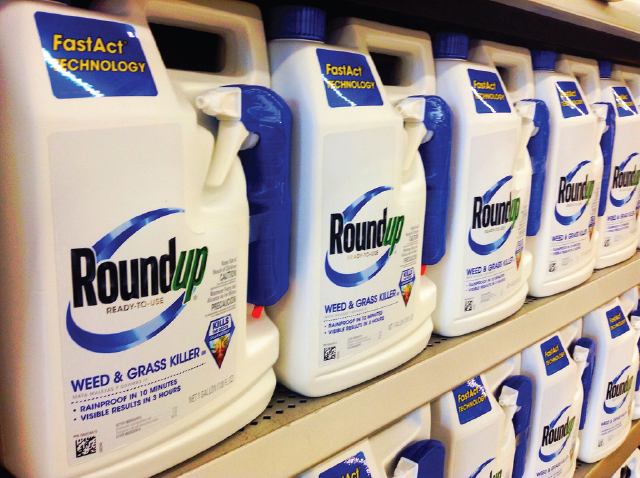
Preface
This blog post will discuss the article published on Jan 9, 2017 in Nature Scientific Reports titled "Multiomics reveal non-alcoholic fatty liver disease in rats following chronic exposure to an ultra-low dose of Roundup herbicide." One of the primary authors of this article Gilles-Éric Séralini has been embroiled in controversy in the past surrounding an article he published in 2012 titled "Long-term toxicity of a Roundup herbicide and a Roundup-tolerant genetically modified maize."
In this article the authors described how long term exposure to corn which had been treated with the herbicide roundup lead to the development of tumors in rats. Unfortunately the experimental design of this article was drawn into question as the strain of rats used by the Séralini group had a predisposition to develop tumors even when never fed the corn the group claimed was the source. As a result of this the article was retracted with the editors of the publishing journal deeming the work inconclusive (source).
I introduce this to provide you with the necessary background information to start from a skeptical standpoint when viewing this work. I have been openly skeptical of the previous reports describing issues with glyphosphate consumption, however I also know that the editorial scrutiny of publication in Nature Scientific Reports is high, and the peer review process is extensive (for instance the article we are about to discuss was submitted in July of 2016 and only just published now. That's 6 months of scrutiny between reviewers and the articles authors.) Is the scrutiny of Nature Scientific Reports as high as the parent journal Nature? Maybe, maybe not. However it is still a high quality journal. Thus I will break this article down for all of you and keep any and all of my biases aside, hopefully allowing you to make up your own mind. This blog may be a bit technical, but I will do my best to explain what things mean and try not to get too bogged down in all of the minute details of the manuscript.
Introduction/What IS Roundup and How Does It Work?
Roundup otherwise known as glyphosate, or for the chemists (N-(phosphonomethyl)glycine) is an organophosphate compound which is used to kill weeds (or any plants really).
Figure 1: Glyphosate
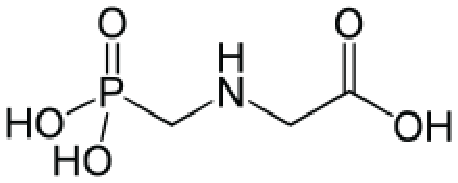
This compound functions by inhibiting an enzyme (called EPSP synthase) which is involved (early on) in the process of synthesizing three (aromatic) amino acids phenylalanine, tyrosine and tryptophan. EPSP synthase is present in plants and some microorganisms but absent in higher eukaryotes such as humans. Stopping the synthesis of these amino acids prevents downstream assembly of proteins and kills the plants. Glyphosate inhibits this enzyme because it is a structural mimic for one of the two molecule that it intends to react with, Phospho-enolpyruvate or PEP.
Figure 2: EPSP Synthase Reaction
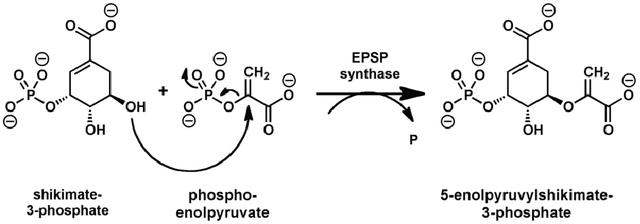
Glyphosate became a popular herbicide upon the introduction of "Roundup Ready" crops by the infamous company Monsanto. These plants carry a modified version of EPSP synthase from the organism Agrobacterium sp. strain CP4 (source). This organism's EPSP synthase is not sensitive to glyphosate, thus is still able to bind and react with PEP as normal even when glyphosate is present. It is due to this modified EPSP synthase that the "Roundup Ready" crops can live, but any other nearby vegetation will die when sprayed with Roundup (glyphosate).
The Article
Let us begin the discussion of this article by summarizing the authors' conclusions. The authors' determined that chronic consumption of glyphosate result in changes to the rats' liver proteome (the total group of proteins expressed by the cells) and metabolome (the total group of small molecule byproducts produced through metabolic processes in the cells). The changes they observed have significant overlap with those observed in people who have non-alcoholic fatty liver disease or NAFLD. They state that the alterations they observed correlate with changes to both the livers structure and biochemical activities.
What Did The Authors Do?
The article describes a 2-year study where rats were given Roundup via their drinking water at a concentration of 0.1 part per billion (0.05 μg/L glyphosate), which is an acceptable concentration according to both European Union (0.1 μg/L) and the United States (700 μg/L) (source).
Upon administration of Roundup, the authors report observing no discernible physical changes to either the experimental rats (those drinking the roundup water) or control rats (those drinking non roundup laced water). However they did observe an increase in blood serum triglyceride levels (triglycerides are the main part of our body fat).
Figure 3: Blood Plasma Triglyceride Levels
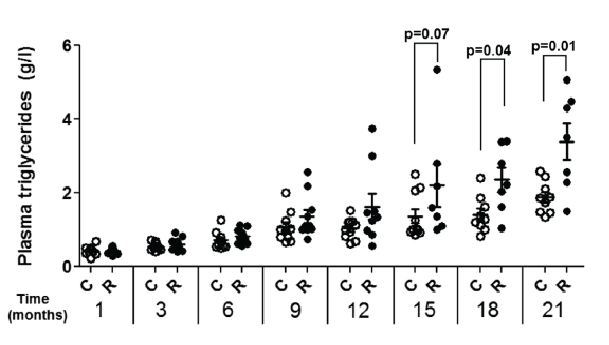
In addition to blood serum analysis the authors took a look at both the proteome and metabalome of control and experimental rats:
Figure 4: Proteome and Metabolome Analysis
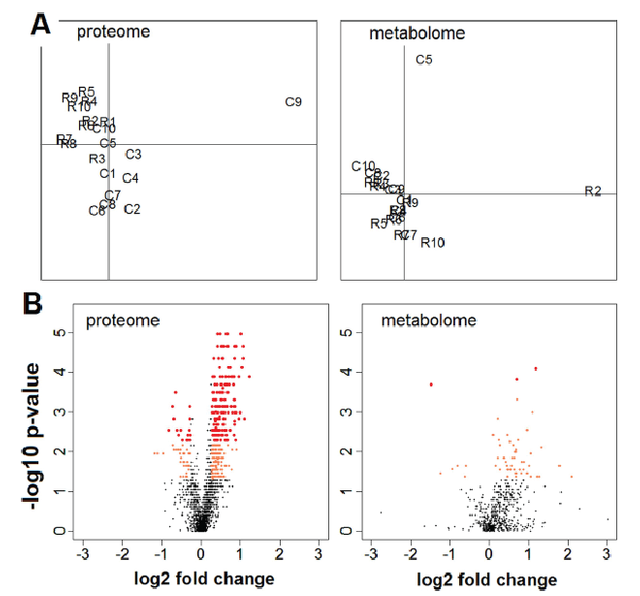
Looking at the figure above starting with the box at the top left, here we are looking at principle component analysis of the protein composition in control rats (identified with C) versus those being given Roundup (identified with R). You can see in the top left box that when looking at the proteome that the C's cluster together and the R's cluster together. This indicates that the protein composition of the control group is more similar to other members of the control group, while the protein composition of the Roundup group is more similar to other members of the Roundup Group, but that the control and Roundup groups are different from one another. Interestingly, this trend is not observed for the metabolome group, where there is no observable difference between metabolic composition between the two groups.
The bottom left hand box is displaying what is known as a volcano plot here each dot represents a protein, and plotted are the change in P-values and expression level changes relative of the Roundup treated rat liver when compared with the control group liver. These plots show that there is a sizable change in liver proteome and some change to the metabolome in the rats consuming Roundup.
In addition to these changes at the termination of the study after two years, the authors reported that Roundup treated rats had more signs of body abnormalities (15 in 8 rats) then control rats (6 in 4 rats), with these abnormalities primarily located in their livers.
Additional Metabolome Analysis Information
The authors report finding in their metabolome analysis the generation of metabolites which are biomarkers for hepatotoxicity (a fancy word for liver damage caused by chemical, be that alcohol, acetaminophen..etc). They also report that biomarkers for mitochondrial fatty acid oxidation were increased. They provide examples of compounds increasing by a factor of two with small p-values 0.0002 - 0.00008 (indicating higher certainty in their measurements). They state that the observed alterations to the liver profiles overlap with those previously reported for non-alcoholic fatty liver disease.
TL; DR?
The authors report evidence for changes to liver protein composition, metabolic byproduct composition, and triglyceride levels in rats exposed to levels of Roundup deemed acceptable by both the EU and USA.
Final Remarks (my biases may be present here)
This study illustrates some interesting findings. However, the authors used a relatively small sample size of rats (10 control and 10 Roundup treated). Additionally the same Harlan Sprague-Dawley that drew criticism for their tendency to grow tumors in Séralini's previous, retracted paper were again used here. That said, this article was not looking at tumorgenesis and I do not know enough about rat strains to wager an opinion whether this was a good or poor choice for a 2 year study.
Sustainable Food Alliance
The work presented by the authors of this manuscript was funded by the Sustainable Food Alliance whos goal is "to educate the public about the positive health and environmental benefits of organic food and farming.” Which of course is not at all biased at all ;)
Questions for Other Scientists of Steemit
What do you think about this publication? What are your thoughts on Séralini's previous work and the controversy surrounding him?
References
1 http://www.nature.com/articles/srep39328
2 https://en.wikipedia.org/wiki/Glyphosate
3 https://en.wikipedia.org/wiki/EPSP_synthase
4 http://www.uniprot.org/taxonomy/268951
5 http://www.pnas.org/content/103/35/13010.full
Thumbnail Image is Available under Creative Commons License from flickr.com
If you like my work, please consider giving me a follow: @justtryme90. I am a PhD holding biochemist with a love for science. My future science blog posts will cover a range of topics in the biology/chemistry fields.
Thank you for your support of my work!
Monsanto should burn in hell. People think they're allergic to wheat, but only about 8% of the population has that allergy. In fact, much of the wheat in our food supply is grown on plants that are drenched in Roundup though their entire life cycle.
Never forget the American Medical Association used to recommend smoking. Or that DDT was considered safe. They'll continue spending many millions of dollars to convince everyone that Roundup is safe, but the evidence is starting to indicate we've been lied to yet again. I wouldn't say it's dangerous without proof, but don't tell me it's safe either.
Monsanto did the technology of genetic modification in foods a huge disservice IMO. A lot of good can come from the technology if used properly (see golden rice for example). But shady business practices have turned a lot of people against the tech as a whole... A few bad apples spoil the bushel.
It could offer some benefits, yes.
The best part of waking up is Monsanto in your cup.
Haha, that might be the worst part of waking up ;)
@justtryme90 I found some of the resources I wanted to cite in case you (all) are interested, here https://avaazmedia.s3.amazonaws.com/Roundupsources.pdf (via the petition here https://secure.avaaz.org/en/monsanto_dont_silence_science_loc_eu/?wGTamib )
Thank you for sharing.
@justtryme90 grow organic - no need for round ups just pest eating insects and gardening know how would also do -
round up is killing so many bees these days
and yet karma is so delayed at taking action against monstersanto
I don't use anything on the plants that I grow.
@justtryme90 me neither . Unfortunately many do :(
Very well written. I agree with your concerns with the study. A sample size of 10 and the bias of funding concern me. However, I believe that even with 10 this should be investigated further and does hold potential to being correct. I worked on a farm in high school. Hopefully the chemicals I sprayed will treat my liver alright!
I hope your liver will be okay too!
I am very happy to read such an article. Finally a proof! This however requires more statistics (the statistical uncertainty on the results is huge). I hope they will continue their work and get a super-clear proof that cannot be discussed.
I am also very happy to have always banned round-up and mosanto from my garden. I refuse to give a single cent to such a company (not for using GMO strictly speaking, but for the way the company behaves).
Yeah Monsanto are shady across the board. Luckily they no longer exist. Were bought out by Bayer last year for around 60 billion IIRC.
Then we still need to wait and see for what bayer will do
Probably something shady, but I'm a cynic.
Upvoted and followed...very interesting stuff here. Thank you.
Thank you for reading, and I much appreciate the follow!
without being able to offer you references, this comment is moot, but I have seen numerous studies disproved, discounted, or defamed by authorities vested in or indentured by Monsanto, who I deem apart of the collective antichrist of agri-petro chemical industries with no concern or conscience with regards to their responsibilities to the environment and to humanity.
Monsanto really did a lot of work to make people think the very worst of GMO technology IMO.
definitely don't want to ingest this stuff...
(btw, following you :-)
Thanks for reading and for the follow, I appreciate it!!
This is really scary. I agree the sample size is small so we need further follow up on this to see if it holds up. I will try to check the paper if I have time - can't really comment on the genomics part as that is way beyond my knowledge level lol! Since metabolic syndrome is associated quite strongly with NAFL this could be at least a partial explanation of the explosion of this and type 2 diabetes in recent years. I would need to have a look at the data on glyphosphate use to see if there is a correlation.
It's certainly indicative that further work needs be done, I don't know that I find it all that frightening yet. At this point I would like to see work done by groups with out a biased funding source find something similar.
At the very least, the evidence does appear to be stacking up that glyphosate as a herbicide isn't particularly a good idea.
I think the scary thing is that this is something that we know is in the environment and people are aware of. The question is what is the effect of all the other stuff we have put out there.
Well there is no such thing as a free lunch so presumably for any upside we have for introducing a compound to do something, there must also be a cost. Whether that cost is significant is another matter. However it is for this reason that basic research, and extensive testing for fundamental properties of basically any chemical is imperative.